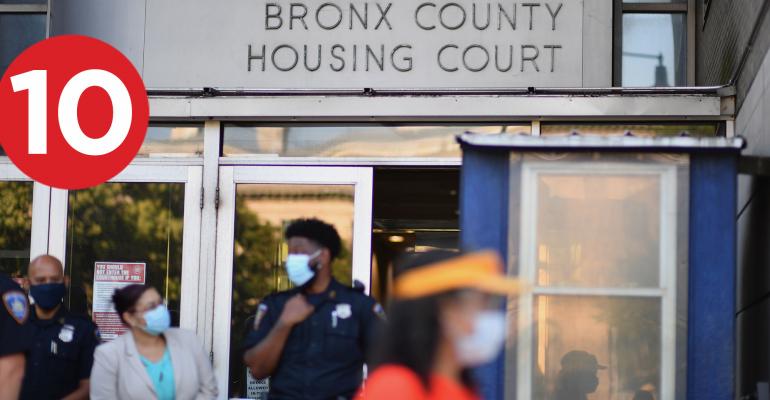- 500,000 New Yorkers Owe Back Rent. What Happens When Evictions Resume? “For roughly 16 months, the city’s renters have been shielded from eviction under broad protections imposed by the federal government and New York State to keep people in their homes during the coronavirus outbreak. But those safeguards are soon expected to come to an end, setting off alarms about the fate of struggling tenants who owe months of unpaid rent, cannot make their next payments and could face homelessness.” (The New York Times)
- CBRE to Buy 60% Stake in Turner & Townsend in $1.3 Billion Deal “CBRE Group Inc. has cut a deal to make one of its largest acquisitions ever, paying roughly $1.3 billion, or £960 million, for a 60% stake in Turner & Townsend Holdings Ltd., one of the world’s largest managers of infrastructure, natural-resources and real-estate construction projects. CBRE, the world’s largest commercial-real-estate-services firm, is buying a controlling stake in the London-based company partly in anticipation of a wave of investment in alternative energy and infrastructure in the coming years.” (The Wall Street Journal)
- Work-from-Anywhere Perks Give Silicon Valley a New Edge in Talent War “Some of the biggest names in tech aren’t just allowing existing workers to relocate out of the Bay Area, they are also starting to hire in places they hadn’t often recruited from before. The result is the most geographically distributed tech labor market to date. That’s leading to above-market rates for workers in smaller hubs, forcing local companies to raise wages to keep up with the cost of living and fend off deeper-pocketed rivals from California, Seattle and New York.” (The Wall Street Journal)
- Satellite Offices Fail to Launch in Big Way “It was just common sense. As the coronavirus made going to the office less and less appetizing, folks would eventually tire of working from home. And commercial real estate experts visualized a future for satellite offices orbiting bigger headquarter hubs. These smaller workplaces out in the burbs — or, in New York City specifically, the outer boroughs — would be closer to where people lived, which would literally split the difference between continuing to stay home and rejoining the rat race. It hasn’t quite worked out that way. At least, not yet.” (Commercial Observer)
- California Puts Up $500 Million for Community Ownership Against Big Real Estate “Too many of her neighbors, says Guzman Ortiz, have already been pushed out of the neighborhood or into the streets because of deep-pocketed speculators swooping in to acquire distressed properties and jacking up rents. But now there is something hopeful on the horizon — the state of California just set aside $500 million for organizations like Fideicomiso Comunitario Tierra Libre to acquire properties along the path to foreclosure, to prevent them from falling into the hands of speculative investors.” (Next City)
- San Francisco Market Update: Development on the Rise “The metro is poised to return to pre-pandemic levels for office deliveries, as there is more than 9.4 million square feet of office space expected to come online in the second half of 2021. This would exceed 2020’s activity by roughly 80 percent and be relatively on par with 2019, when 9.5 million square feet of office space was delivered. Life science and R&D spaces continue to be the most in-demand assets in the market, comprising some of the largest projects currently underway. In June, Kilroy Realty broke ground on Gravitate, the 860,000-square-foot second phase of Kilroy Oyster Point, in South San Francisco.” (Commercial Property Executive)
- The Bipartisan Battle Against Big Tech Could Boost Washington’s Office Market “Law firms and lobbying firms, two of the largest sectors in D.C.'s office market, are seeing a bump in business as big tech companies face antitrust scrutiny.” (Bisnow)
- States That Cut Unemployment Early Aren’t Seeing a Hiring Boom, But Who Gets Hired Is Changing “States that scaled back unemployment aid have seen a decline in teen employment and an increase in workers over 25, early evidence has found.” (The Washington Post)
- Europe Sees Vaccine Passport Explosion for Hotels, Restaurants, Museums and More “As the delta variant of Covid-19 surges across the continent, many European countries are now using less carrot and more stick.” (Forbes)
- Groceries in 10 Minutes: Delivery Start-Ups Crowd City Streets Around the Globe “Shut at home for months on end during the pandemic, millions of people started using online grocery delivery. Delivery subscriptions for many things, including wine, coffee, flowers and pasta, surged. Investors have seized this moment and are backing companies that will bring you whatever you desire, not just soon, but within minutes, whether it be baby diapers, frozen pizza or a chilled bottle of champagne.” (The New York Times)
0 comments
Hide comments





